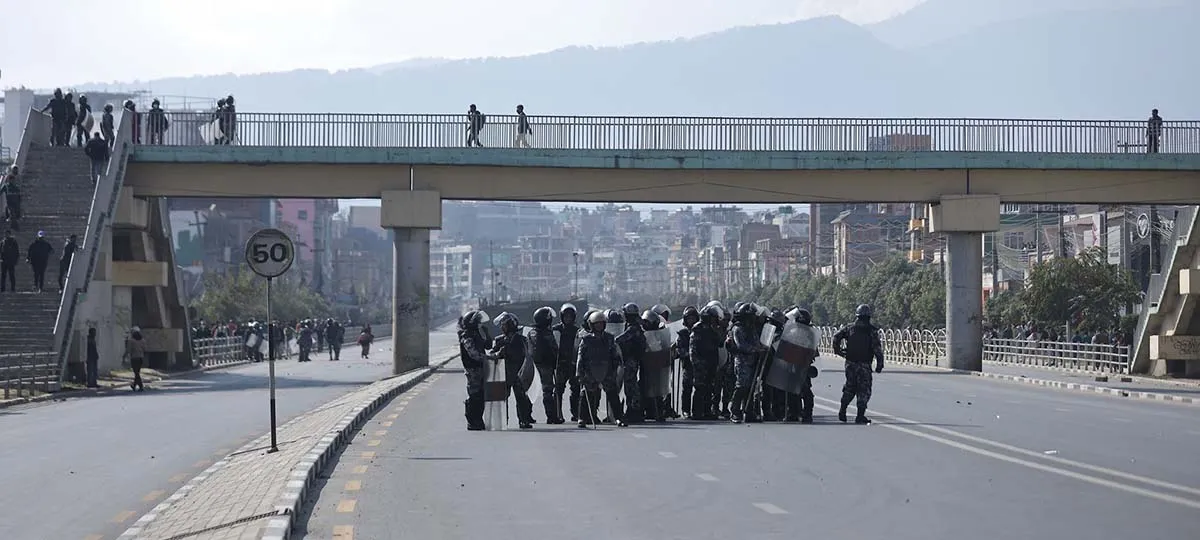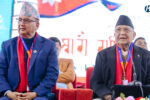KATHMANDU: In the heart of Lalitpur, the once-peaceful Balkumari turned into a battleground for a different kind of terror – not the infamous “red terror” associated with the communist-led government but a disturbing manifestation — “white terror.”
Last Friday, the government, led by the red-robed Maoist party supremo and backed by a Home Minister with a “red” (communist) background, shocked the nation with its brutal crackdown on the unemployed youths in Balkumari.
The term “white terror” encompasses the violence, atrocities, and oppression inflicted by the state upon its citizens.
The incident in Balkumari is not an isolated event but part of a longstanding series of white terror, exemplified by the unjust policies associated with the EPS Korea branch and the exploitation of the youth, which erupted into chaos on the streets last Friday.
The confrontation resulted in the tragic deaths of two Nepali youths, Birendra Shah from Achham and Sujan Rawat from Dailekh, at the hands of the police.
As the government wielded batons, boots, tear gas, and bullets against unemployed youth, dreams were shattered, and the future of the destitute was stolen.
The burning of the incumbent minister’s car during the protest further underscored the magnitude of discontent, prompting serious questions about the efficacy of our state system.
The critical query that now arises is: Who is responsible for the riots on Friday? What precipitated this crisis? To understand the roots, it is crucial to examine the events that transpired in Balkumari on that fateful day.
Police Negligence Leads to Tragedy
Birendra Shah, a 23-year-old aspiring individual from Achham, had excelled academically, completing his 12th standard at the local SUD High School.
Last July, the EPS Korea branch under the Ministry of Labor, Employment and Social Security conducted a language test for working in a shipbuilding company. About 30,000 Nepalese participated in the exam. However, the quota is only about 3 thousand.
Driven by the desire to contribute to his country, Shah came to Kathmandu to study the Korean language, part of a wave of young people seeking opportunities in Korea.
Despite his promising academic record, Shah met an untimely demise on Friday, succumbing to two bullets fired by the police.
In a separate tragic incident, 23-year-old Sujan Rawat of Dailekh lost his life in the Balkumari clash.
Admitted to Lalitpur’s Kist Hospital, Rawat did not fall victim to bullets but suffered fatal injuries from police beatings, displaying bruises all over his body.
Having assumed responsibility for his family following his father’s death the previous year, Sujan sought employment in Korea to support them.
Having arrived in Kathmandu just a month ago to take the Korean language test, his aspirations were tragically cut short.
Sujan, who was learning Korean at an institute in Baghbazar, lived in Thankot with the shelter of his uncle’s son.
He reached Balkumari on Friday to see the movement of young people who studied Korean like him.
However, he died from the merciless baton of the police. 46-year-old mother Nanda Kumari’s face was wiped off with vermilion, this time her arms were open.
According to the details given by the Lalitpur District Administration Office, two people died in the incident on Friday.
The government claims that 4 policemen and 3 civilians were injured.
Police arrested 73 people including a woman in the incident. They have bene released on Sunday.
Specific reason for the incident
South Korea became an attractive destination for Nepali youths for foreign employment.
It is also an obligation for the youth who have not found employment in the country.
Korea achieved prosperity, but the leaders of Nepal brought the country to a waste state of exporting workers.
By learning the Korean language, one can get a government job under the Employment Permit System (EPS) and since the minimum salary is up to Rs 2 lakhs per month, employment in Korea is considered better and safer than in the Gulf countries.
Due to this, the number of people studying Korean language and trying for employment in Nepal is tens of thousands.
However, the number of employment opportunities is not enough to meet this number.
Until now, Korea had been assigning Nepali workers in the productive sectors of agriculture, animal husbandry and construction.
Some Nepalese were also employed in shipbuilding. Lately, it has signed a MoU with the Ministry of Labor and decided to formally take workers to the shipbuilding company, for which it has set a quota.
It is transporting workers from one and a half dozen countries like Nepal to the shipbuilding company.
The number of young people who participate in the Korean language test for the purpose of going for employment is increasing.
Following the EPS branch’s notice on December 5, 2023, indicating a demand for workers in the manufacturing sector, applicants for the ship in July expressed interest in switching to the manufacturing sector.
Last year, the number of people who applied for sick leave in agriculture, animal husbandry and production sector was 44 thousand 853.
Last July, the EPS Korea branch under the Ministry of Labor, Employment and Social Security conducted a language test for working in a shipbuilding company. About 30,000 Nepalese participated in the exam. However, the quota is only about 3 thousand.
A total of 3,989 individuals have successfully completed the language test for employment in the shipping company.
Subsequently, they are required to undergo a health examination and complete the employment application form.
The EPS branch of the Foreign Employment Department issued a notification on Friday outlining the procedural steps.
The health examination is scheduled to take place from January 1 to 3, 2024.
Applicants are advised to wear trousers and a vest to the designated hospital and abstain from consuming fish, meat, or alcohol for two days prior to the health examination.
Upon successfully passing the health test, candidates are instructed to fill out the employment application form online from January 7-17, 2024.
The application process entails candidates who have successfully passed both the language test and health examination filling out the employment application form.
Those selected through this process proceed to sign a labor contract facilitated by the employer through the Human Development Department (HRD) in Korea.
Subsequently, they undergo a one-week training session at the Vocational Skill Development Training Center in Bhainsepati.
Further training takes place in Korea before individuals are assigned to their respective roles.
Amid the ongoing selection process for shippers, a new wave of unrest was triggered by a notification from the EPS branch last November.
On December 5, 2023, the EPS Korea branch issued a notice inviting applications for positions in the manufacturing sector in Korea.
However, this opportunity was limited, excluding those who had taken the shipbuilding company exam.
Notably, passing the language test did not guarantee a job in the shipping company.
The process involved creating a roster of successful candidates, which was then sent to Korea. The Korean company would make the final selection from this roster.
Despite the multitude of applicants for the language test, the EPS staff decided to accept applications only from the initial 18, causing frustration and leading to a protest that disrupted traffic on the ring road in Balkumari, Gwarko.
Previously, the Nepal government compiled a roster of 892 individuals, but only 238 were selected for the ship.
In the next phase, preparations were underway to create a roster of 2,500 people.
However, with 3,989 individuals taking the language test and a total of around 32,000 aspirants, the demand far exceeded the available opportunities.
Following the EPS branch’s notice on December 5, 2023, indicating a demand for workers in the manufacturing sector, applicants for the ship in July expressed interest in switching to the manufacturing sector.
However, the EPS branch made a decisive ruling, disallowing those who applied for the ship to fill out the employment form for the manufacturing sector.
The incident involving young individuals on Friday stemmed from this EPS branch decision.
Eighteen young people sought justice at the Patan High Court after being informed that they could not fill out the employment form for the manufacturing sector.
The High Court ruled in favor of the petitioners, allowing them to complete the form.
Subsequently, on Friday, they proceeded to the EPS Korea branch office in Gwarko to submit forms for manufacturing jobs.
However, the situation escalated when not only the original 18 but thousands of youths gathered, assuming they could also apply.
The Lalitpur police were unaware of the minister’s impending arrival, and before the Koteshwar police could mobilize towards the Balkumari bridge, the minister’s car had already departed from the ring road.
Despite the multitude of applicants for the language test, the EPS staff decided to accept applications only from the initial 18, causing frustration and leading to a protest that disrupted traffic on the ring road in Balkumari, Gwarko.
The government claims approximately 2,000 youths participated in the protest.
The incident took place in Lalitpur, where protesters gathered near the bridge close to Balkumari and Gwarko.
Approximately 2,000 individuals expressed their discontent, and tensions ran high.
A contingent of about 125 police officers from Lalitpur was stationed on the Satdobato side.
As the Kathmandu police traversed the Balkumari bridge en route to Koteshwar, they entered an area already under surveillance.
Curiously, there was an absence of Koteshwar police, leading to a possible misunderstanding where Kathmandu police assumed the responsibility lay with Lalitpur police.
During this episode, Physical Infrastructure and Transport Minister Prakash Jwala needed to attend a meeting of the Unified Socialist Party at a party palace in Lalitpur.
As the driver prepared to take him to the Gwarko area, the minister’s Personal Security Officer (PSO) discovered the ongoing demonstration and promptly informed the Kathmandu police.
If such dual applications were deemed impossible, why was this notification issued? This raises the suspicion that denying the language test to certain applicants was an unjust act.
The Lalitpur police were unaware of the minister’s impending arrival, and before the Koteshwar police could mobilize towards the Balkumari bridge, the minister’s car had already departed from the ring road.
With 125 Lalitpur police positioned outside the protestors’ cordon and the absence of Koteshwar police, the minister found himself in a vulnerable situation.
Questions regarding accountability emerged from this incident. To what extent is the PSO responsible?
Did the minister make an error in judgment? Is the Koteshwar police culpable?
The need for coordination between Lalitpur and Kathmandu police raises concerns.
Are the responsibilities of the PSO limited to the minister’s security, or does it extend institutionally?
These questions, born out of the recent events, highlight the necessity for clarity in the chain of command, emphasizing that the law applies to all.
In the aftermath of the tragic deaths on Friday, the EPS branch made an unexpected move.
On the same day, it called for re-applications for employment in Korea’s manufacturing sector, where the initial attempt was disrupted.
However, the department imposed a restriction, allowing only participants from shipbuilding companies to take the exam.
Applications can be submitted from January 1-3, 2024, and the notification explicitly states, “Only applicants who have filled out the form in the shipbuilding sector in the year 2023 can apply. Others will face automatic cancellation if submitted.”
Why did the government initially prohibit applicants from the shipping industry from taking the exam in the manufacturing sector?
Until Friday, officials from the department defended their stance with a bold argument – Korea’s alleged non-recognition of the two-way test, claiming their hands were tied.
However, this argument from the EPS staff appears inconsistent for two primary reasons.
Firstly, thirty thousand individuals out of the three-thousand-quota have already taken the shipbuilding exam, indicating there is no inherent limit on the number of people who can take the language test.
Importantly, the language test is not equivalent to a job application; the employment form is submitted later, after the health examination.
Korean language teaching institutes, scattered across Bagbazar, Anamnagar, and other areas of the Kathmandu Valley, have lucratively capitalized on selling the dream of Korea to Nepalese youth.
Secondly, following the unrest and casualties in Balkumari on Friday (December 29, 2023), the EPS branch issued a notification overnight stating that those who had filled out forms for watercraft could also apply in the productive sector.
If such dual applications were deemed impossible, why was this notification issued? This raises the suspicion that denying the language test to certain applicants was an unjust act.
The Patan High Court’s two orders further affirm that EPS employees have acted improperly.
The EPS staff’s control-oriented mindset and the restrictive approach to the language test are further underscored by a specific detail in the notification published on December 29, 2023.
The notification explicitly states that only those who have filled out forms for the ship should apply, and any attempts by others will be automatically canceled.
One might question the rationale behind limiting opportunities, whether for boats or airplanes, by not allowing all deserving young individuals to fill out the forms once the process is open. It appears that EPS employees have yet to demonstrate generosity in this matter.
Analyzing these factors, it becomes evident that the control-oriented policies adopted by the EPS branch employees are a significant factor in exacerbating the frustration among unemployed youth.
Three Levels of Exploitation
The income generated by the state through various fees imposed on applicants is substantial.
However, the government does not seem inclined to contemplate reductions or ease the financial burden on the youth.
There exists a regulation stipulating a fee of $28 (equivalent to 3,700 Nepalese rupees) for employment applications.
The extent to which the Nepal government extracts funds from unemployed youth becomes even more apparent when considering the health examination fee alone, which stands at 7,300 rupees per person.
Health examinations are conducted at various facilities, including Patan Hospital, Shukraraj Tropical Hospital Teku, Nepal Korea Maitri Hospital Bhaktapur, and Civil Hospital Naya Baneshwar.
The 3,989 individuals who applied for the shipbuilding company are undergoing health check-ups at these hospitals from January 2-4, 2024 each paying 7,300 rupees.
Interestingly, the fee charged by the government for this health examination surpasses the cost of a ‘whole-body checkup’ conducted by private hospitals.
Charging such a hefty fee for an unemployed examination appears impractical and adds to the financial burden faced by the youth.
The core issue lies within the leadership of the Ministry of Labor and Employment, and questions arise about the whereabouts of Minister Sarat Singh Bhandari during the incident.
Korean language teaching institutes, scattered across Bagbazar, Anamnagar, and other areas of the Kathmandu Valley, have lucratively capitalized on selling the dream of Korea to Nepalese youth.
Simultaneously, the government has been amassing crores annually through exam fees from unemployed youth.
Under the guise of health examinations, select hospitals impose exorbitant fees, contributing to the flourishing of unemployment across three levels instead of alleviating it.
Annually, between 30,000 to 40,000 young individuals channel money into institutes, government coffers, and hospitals, aspiring to venture to Korea.
Could the government not consider reducing the exam fee from 3,700 to 1,000 or less?
Is it not possible to lower the health examination fee from 7,300?
Shouldn’t the government actively oversee and curtail the unbridled collusion between consultancies and EPS employees?
What is the Ministry of Labor’s stance on these matters? Can the government afford to turn a blind eye to the myriad challenges faced by unemployed youth? These pressing questions demand simultaneous attention.
Meanwhile, in response to the incident where two individuals lost their lives during the demonstration in Lalitpur, the government has established a three-member investigation committee.
DIG Lalamani Acharya of the Valley Police Office heads this committee, with Assistant CDO of Lalitpur District Administration Office Amardeep Sunuwar and Deputy Director of the National Investigation Department Basu Sigdel as members.
While the government did not suspend SSP Siddhi Bikram of Lalitpur district and Lalitpur police chief, it did relieve them of their duties and summoned them to the head office.
The government has taken decisive action by suspending Lalitpur DSP Umesh Lamsal, IAPS Korea branch director Subedi, and Minister Prakash Jwala’s bodyguard ASI Sunuwar, all of whom were stationed in the field during the recent incident.
Furthermore, in a meeting of the Council of Ministers, decisions were made to provide Rs 10 lakh each to the families of the deceased and cover the treatment expenses of the injured.
Simultaneously, Prime Minister Pushpa Kamal Dahal convened a meeting with the Home Minister and the Chief Secretary on Sunday.
During this meeting, he instructed the formation of a high-level investigation commission led by a former judge. The government is poised to establish this inquiry commission on Monday.
Now, the government is confronted with its own question – what purpose does it serve by collecting examination and health fees from 30,000 to 40,000 youths annually?
While these preventive and remedial measures in response to Friday’s incident are a positive step, they are deemed insufficient. This is mere eyewash.
The core issue lies within the leadership of the Ministry of Labor and Employment, and questions arise about the whereabouts of Minister Saratsingh Bhandari during the incident.
The activities of the director-general of the EPS branch remain unknown, and there is a lack of transparency regarding the utilization of the substantial funds raised from unemployed youth.
The fairness of exams and selections, as well as potential misconduct, is not being adequately monitored.
The reasons behind the high costs of health tests in government hospitals remain unanswered.
This underscores the need for comprehensive scrutiny and accountability within the system.
Addressing these unresolved questions is essential, as the resolution of the issue appears contingent on understanding the circumstances that led to the torching of the minister’s car on Friday.
A few weeks back, Prime Minister Pushpa Kamal Dahal pondered the unanswered question of why people are seeking opportunities abroad.
Now, the government is confronted with its own question – what purpose does it serve by collecting examination and health fees from 30,000 to 40,000 youths annually?
Furthermore, the use of force, employing sticks and bullets against unemployed youths, raises the critical question of the government’s actions.
Will a mere investigation committee be formed, or will there be legal accountability?
Should the Personal Security Officer (PSO) be penalized while the higher-ups enjoy immunity?
This potential discrepancy must be addressed promptly to prevent the eruption of anger elsewhere, catching the government off guard.









Comment